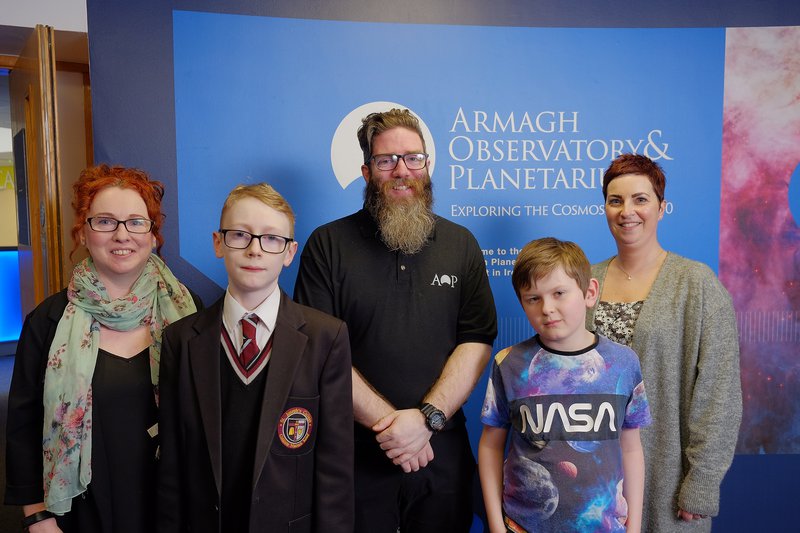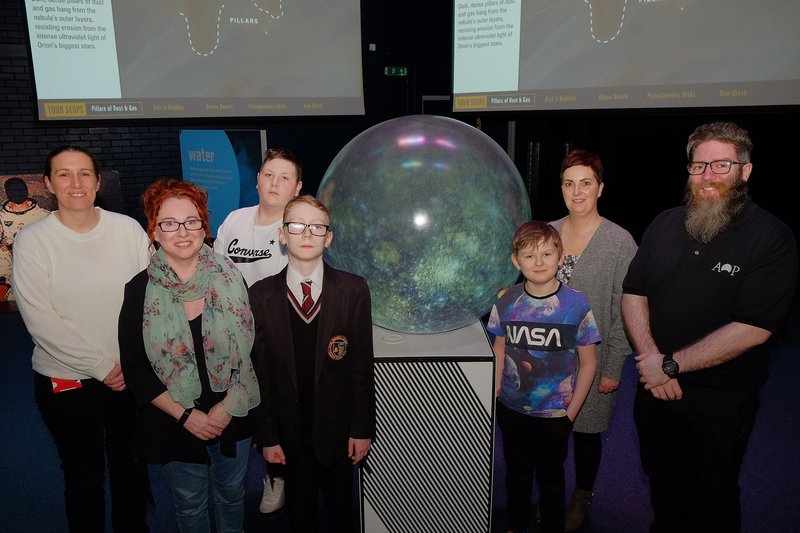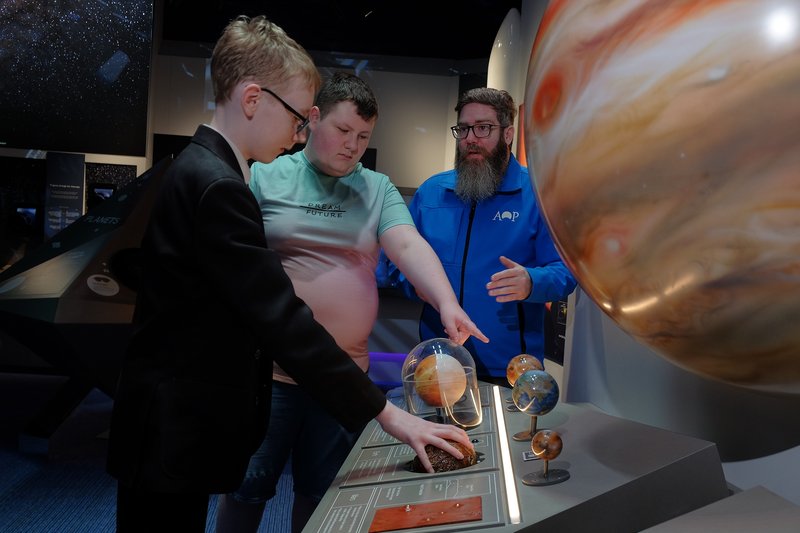Autistic Youth Forum: transforming accessibility and engagement at Armagh
Armagh created a youth forum of children with autism giving them the power to drive change around accessibility at the observatory and the delivery of their programmes.
Who did you work with?
More than Words (Community group) working with children with autism
Middletown Centre for Autism (Community Group) working with children with autism
Special schools in Northern Ireland
Had you worked together before?
We had not worked together with Middletown Centre for Autism or More than Words on a project level before but had been aware of the community groups in Armagh having had visits through annual trips, but we did not have a deep engagement.
In relation to special schools, we had an engagement level of only 8% of special school in NI who had visited us.
What priorities did you identify with your partner and how did this project meet the longer-term priorities of everyone involved?
Our priorities were to ensure that the current programmes we were running as relaxed sessions were of benefit to children with additional needs and the steps we were taking were the correct steps to take. To enable us to do this we created a youth forum with the main aim to have children on the forum that would give honest feedback on what they need, increase their confidence in working with others and a science centre and for the children to see real change happening based on their feedback and suggestions. We wanted to bring children together to communicate together in a safe environment and the community groups were keen to get involved. For the groups they took pride in being involved in the project, but more in how their children were interacting, the joy of seeing the changes they were making the growing of confidence within them.
For the special schools our priority was to take our learning from the forum and bring it into practice on outreach to special schools. We wanted to give as many children with special educational needs the chance to experience science and to increase our engagement figure from 8%. For teachers they wanted their pupils to get an experience and for us to help them with STEM demonstrations. Our outreach officer offered help longer-term in how to use practical demos for teaching science, resources were shared (in particular a free experiment book given to each school). For further engagement with AOP our outreach officer provided his contact details for follow-ups and to be a point of contact should any school ever have an astronomy or science question.
Summary of the aims of your project delivery
The aims of the project were to create a youth forum of children with autism that would drive change around accessibility, enhancing delivery of our programmes, creating physical kits that benefit visitors, all whilst increasing the forum participants confidence showing them that science is for them. Using learnings from the forum an aim was to increase engagement with special schools in NI from an 8% level delivering our outreach programme to engage with both SEN pupils and teachers.

“Very informative and the pupils loved the dome. The visuals of the stars and the planets were great 👍”
“We enjoyed the sensory, awe-inspiring visuals in the star dome!”
“Very well organised, perfectly presented, very warm rapport with children, and children fascinated and happy”
How co-produced was your programme?
- Deciding together (encourages new and additional options, and joint decision making)
- Acting together (not only deciding what is best together, but forming a partnership to carry it out
What steps did you take with your community partner in order to reach this level of co-production?
For the youth forum we met on a monthly basis in our boardroom on a quiet afternoon at the Planetarium. The dates and times were set to suit all in collaboration. The first meeting was arranged to allow the children to mix and meet everyone in a safe environment and to gain confidence around each other. The themes and agenda for each session were set by Education Assistant Mark Grimley and community partners would give their views and areas they wanted to explore for further sessions. The children said that they liked the boardroom for the meetings as it made the sessions feel special and of importance, so we ensured that each session started in that room.
All decisions were in collaboration with the group and AOP in terms of what products to buy for sensory bags, what areas to focus on for the sensory map and in terms of how relaxed sessions were run the children gave their views on how they could be run better in terms of sound, noise, capacity. The forum was informed of all decision making and could see the actions taken had come from their feedback which on feedback the leaders of the groups said gave them confidence to speak up as they could see their views were being taken onboard.
Can you note down some of the benefits and challenges to working this way?
Benefits
- Trust building and better engagement
- Giving the forum confidence in communication and treated as equals
- Ensured that people were at the center of the project
- Kept focus on aims and objectives
- We learned more about needs of hildren with autism
- Working with not for
- Project felt customer focused and could draw on each other's lived experiences
Challenges
Only challenge faced was setting up meetings between two groups that would suit everyone involved so took time to pre-plan
What was the STEM link?
The forum worked on how we could improve our accessibility during STEM workshops. This in particular had an astronomy focus.
For the special schools we focused on astronomy and the planets in particular as well as bringing practical items to hold and touch (meteorites). At schools where the dome was too big, we made rockets and did science experiments.

What happened?
The youth forum really gelled effectively at the first meeting. We had one participant who came from Omagh to Armagh (2.5hr round trip) for each meeting. The family valued the activity as their child who would be shy and quiet became involved and communicated effectively with the other participants. The group participated fully with the agenda of each meeting and after the meeting if there were changes that we could make the team at AOP ensured that the changes were made before the next forum meeting so the children could see the changes they were making, and their views and ideas being put into action. The group had many ideas on how to increase accessibility and what items would work well in sensory bags, from space themed ear defenders to stress balls.
With the special schools we found that many schools wanted an outreach visit from us with our dome. The communication with the schools on how to create a programme that suited all children taking their views and ours on how the sessions could run was a success and the teachers commented on how valuable the outreach sessions were for the children. Practical demonstrations and visuals can aid learning and show how science is for all and that was a common theme with the special schools – that the children were getting a chance to experience an interactive activity. One teacher is particular said that the funding of the outreach for their school could be the only time that the children get to experience science and astronomy in such an interactive way.
“A brilliant experience for the children and staff alike. A first and only time for many children with special needs as well. The provider was considerate to the needs of the children too.”
What challenges might lie in wait for someone wanting to replicate this project
A challenge would be to get the right mix for the forum in terms of children. Through the collaboration with our partners, we were able to get children that were talkative alongside children that had a quieter personality which benefitted with bringing them “out of their shell”.
Time and patience are needed working with the forum to allow for changes in the agenda, and to work with the children in the flow of what they want and need.
Were there any surprises?
For the outreaches, the special schools in particular loved the outreach dome and the visual nature of the content. This took us by surprise as we thought they may opt for experiments as the dome can be quite dark. The feedback was that this activity was the favourite for the children and one that created a lasting memory.
We received a lot of feedback from SEN mainstream school units and SEN groups that wanted to take part in the outreach element. The lack of funding in the area of mainstream schools and in particular how the teachers felt a visit from us would be more valuable that attending in person took us by surprise. This is an area and a direction that we want to explore further – how we can gain funding to extend this project to SEN units in mainstream schools.
Our Education Assistant Mark Grimley immersed himself in this project and, as a new member of the team, really gained skills in leading a forum and communicating his ideas to management. It was great to see his development throughout the project and was an unexpected outcome as we focused much of the outcomes on the partners and not on the benefits of our staff! Also, all staff have learned so much from the forum and been able to implement changes to their live shows in terms of sound and lighting!
How did you capture/measure the impact for this project?
We used survey monkey to capture feedback from the schools.
Some of the results:
- The project received a 5/5-star rating
- 0% would change anything about how the project was delivered
- 100% would book a visit from us again
- 100% of schools said we met their expectations in terms of educational content
- 100% of schools said that the funding was essential and without the Bold Futures fund they would not have been able to have experienced the project
- 85% if schools would book again but would need funding due to finances and 15% of schools said they would be booking regardless of funding
Verbal feedback taken from the forum.
Social media was monitored for any posts on our accessibility.
For the special schools we started at an 8% engagement level, and this increased to 66% over the course of the project. Some schools through the project only found out that we offered an outreach element and they booked both an outreach for half the school and an in-reach for the older students.
Where is the long-lasting change?
The changes that the youth forum have made are actioned and have shown us how listening in partnerships and working with groups not for them can bring huge gains and benefits to our organisation. This model has been discussed at management level where discussion with groups is essential.
We have made links with the Middletown Centre for Autism and More than Words and in fact we continued the youth forum on during the summer as this was feedback from the group that they enjoyed the engagement and activities and the chance to meet up together. We will be organising star gazing evenings with the groups help to make them more accessible starting in October – so this group is continuing beyond the funding allocation. This small forum has had a big impact!
From feedback from the special schools, we are sending the results of Bold Futures to our education department to seek funding to allow this element of the project to continue. We also had queries from SEN units in mainstream schools and want to look at a further project that can fund outreach in this area. The Bold Futures project has demonstrated to us the importance of funding and even part-funding these programmes to under-represented audiences.
Lasting change on our website with the accessibility changes (top left hand side of the site is a widget to make changes). Also more awareness around website accessibility and the need to be descriptive – every changing and evolving.
Did this project impact the future sustainability of your organisation?
The project has shown us new ways of doing things, partnerships and collaborations. It has enabled us to look outside the box on projects and how we can work with partners and not always doing projects for partners.

Online resources
The children have been producing information for our accessibility page and populating it. Bold Futures video at the bottom of the page: Accessibility - Armagh Observatory and Planetarium
Press release on the project: ARMAGH OBSERVATORY AND PLANETARIUM CREATES BOLD FUTURE FOR LOCAL SEN COMMUNITY – Astronotes (armaghplanet.com)
The children expressed the wish for our AOP experiment book to go online so they could be downloaded from home and a PDF was made and added to resources: Educational Resources - Armagh Observatory and Planetarium
Explore Your Universe Valuing Inclusion February - June 2024
Inclusive Outcome Areas: Agency & ownership, Possible Selves, Social connection, Developing skills.
Building on the success of their Bold Futures programme, the team at Armagh Observatory & Planetarium worked closely with their community partner lead, Joanne McCracken who runs a local charity called More than Words to further engage with this community group. This community group works specifically with children with autism, providing evening activities, day trips and support for families.
During the Bold Futures programme, Armagh Observatory & Planetarium and More Than Words worked together to create a youth forum where children with Autism were given ownership to make change, advising on SEN events the centre delivers and the accessibility within the centre itself. After seeing changes being made from their suggestions, the children felt part of the organisation. The youth forum provided ownership and gave the children the ability to lead and make purposeful change, such as introducing sensory bags and maps which have been utilised by the public.
For this programme, Armagh Observatory & Planetarium collaborated with More Than Words and the youth forum to focus on their onsite programming, targeting underrepresented groups to visit the centre by creating an accessible two-hour monthly weekend session and two-hour afternoon sessions. They utilised their subtitled shows, sign language shows and created a new Makaton dome show, which was developed during this programme. You can view a highlights video here.
In total they engaged with 111 individual participants across eight 2-hour visits. Each visit included a planetarium show that covered topics such as ‘Atoms from the Big Bang to now’, ‘Our Night Sky’, and ‘Moon phases and the Sun’. Each group of children had a range of additional needs and some groups were on the autism spectrum.
[1] ASDC programme funded by the Wellcome Trust, that ran from January 2023 to August 2023 with a focus of collaborating with communities and under-represented audiences.
“Families with kids with autism or additional needs would often limit themselves to where they can go but now after seeing the changes at Armagh Observatory & Planetarium they can now consider a day out with less stress” - More Than Words

The Armagh Observatory & Planetarium provides them with a map and walkthrough video (available on their website) to be able to show the children in advance what to expect so that they feel calmer about their visit. “Kids will come in nervous, not sure what to do when they arrive and then they start to get into the activities and their confidence builds. They go from really quiet to super chatty in a heartbeat.” – Project lead, Armagh Observatory & Planetarium
The community partner shared that one child has since requested to do a triple award science GCSE, which wasn’t available to him before. “He had never thought it was an avenue before but has really taken to science now.” – Community partner, More Than Words
Astronaut George with Makaton signing – New planetarium show with Makaton signing created as part of this project.
Please see below the Explore Your Universe: Valuing Inclusion report by Jen DeWitt and Sophie Bartlett. This report delves into the findings from the grant programme and how effective the 6 inclusive outcome areas were.
